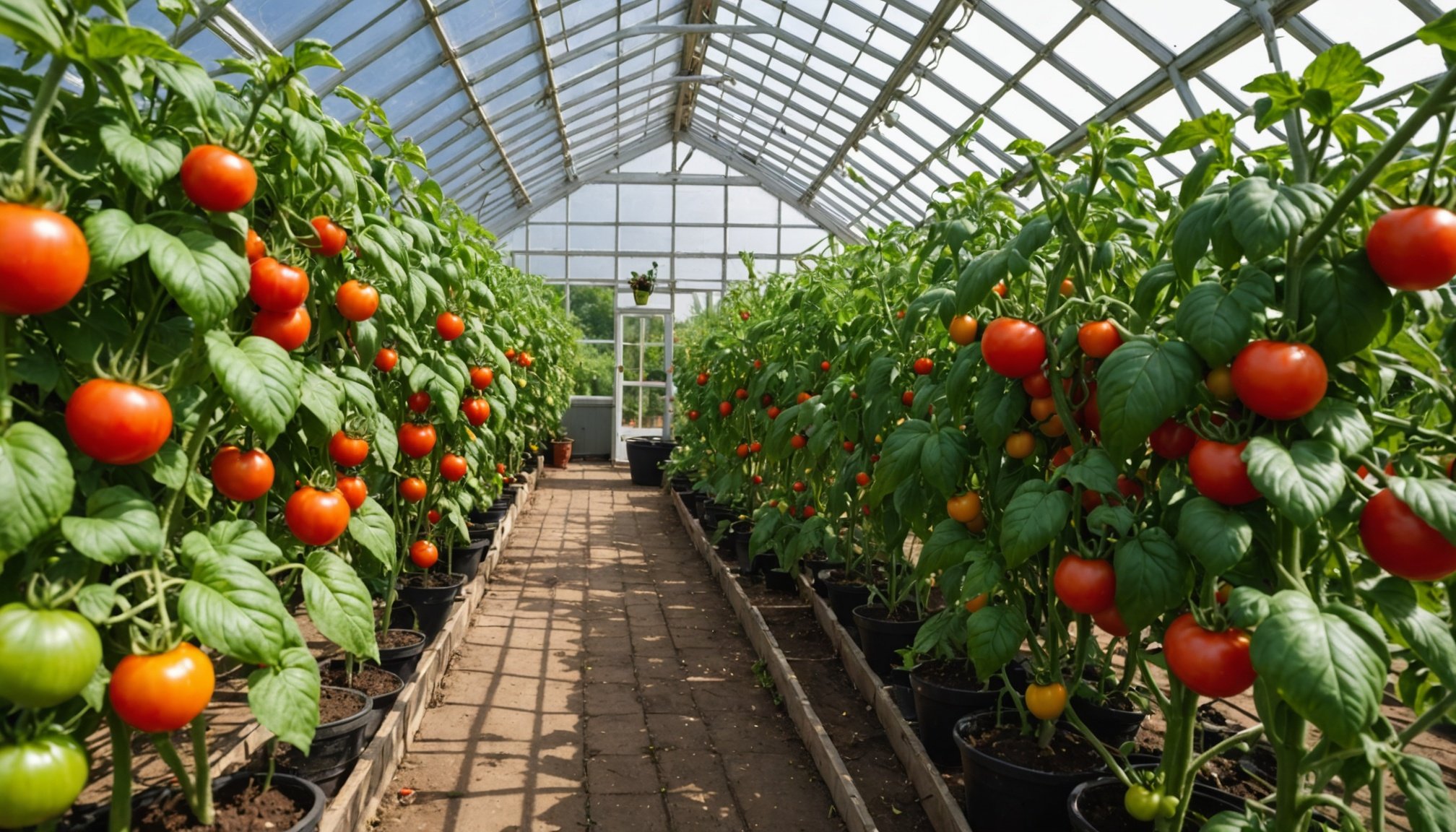Ideal Tomato Varieties for UK Conservatories
When selecting tomato varieties for UK conservatories, it’s crucial to choose ones that can flourish in controlled environments. These conservatories provide a unique climate that can be warmer and more stable than the typical UK climate, making it possible to grow varieties that prefer such conditions. With the right selection, one can enjoy a bountiful harvest even within the glass confines.
Certain types stand out for conservatory cultivation due to their adaptability. Varieties like Cherry Tomatoes and Roma are well-loved for their robustness and exceptional taste. Cherry Tomatoes are smaller, round, and perfect for salads, while Roma tomatoes are meaty and excellent for sauces. These types not only adapt well but also use the space effectively since they can be trained to grow vertically.
A lire en complément : Discover the UK’s Top Rapid-Growing Hedge Varieties for Ultimate Privacy!
Choosing the right seeds and seedlings is equally important. Look for seeds from reputable suppliers that guarantee high germination rates. It’s also beneficial to opt for disease-resistant varieties to reduce potential challenges. Paying attention to seed packet instructions regarding planting times and depth can enhance growth success. The combination of the right tomato varieties and careful seed selection can truly transform conservatory gardening experiences.
Optimal Growing Conditions
Creating the best growing conditions for tomatoes in conservatories is essential for a successful harvest. The ideal temperature for tomato plants typically ranges between 18-24°C (64-75°F). This temperature range encourages optimal growth and fruiting. Ensuring consistent warmth is crucial, as temperatures below 13°C (55°F) can hinder growth, while temperatures above 30°C (86°F) might cause blossom drop.
A lire en complément : Maximizing Garden Shed Efficiency: Budget-Friendly Insulation Solutions for UK Homeowners
Light requirements play a pivotal role in developing robust tomato plants. Tomatoes thrive in full sun, needing at least 6-8 hours of direct sunlight daily. Position your conservatory or arrange reflective materials to maximize sun exposure, ensuring even those tucked-away corners receive light. Keep in mind that artificial grow lights can supplement natural light when necessary, particularly during shorter winter days or in less sunny regions.
Humidity and ventilation are also critical components. Tomatoes prefer moderate humidity levels, ideally between 40-70%. Proper ventilation within the conservatory is essential to maintain airflow and prevent diseases like mould. This can be managed by installing vents or using fans to circulate air. Remember, balancing these growing conditions can significantly enhance the overall health and yield of your tomato plants.
Soil and Fertilizer Recommendations
A prosperous tomato cultivation demands attention to soil quality and adequate fertilization. The first step is to choose the best soil mixes. For conservatories, a well-drained soil enriched with organic matter is recommended. Loamy soil fits this description, providing essential drainage and nutrients.
Tomato plants require key nutrients, emphasising nitrogen, phosphorus, and potassium. These nutrients bolster plant health, fuel growth, and encourage abundant fruiting. Nitrogen supports leafy growth, phosphorus enhances root development, and potassium boosts flowering and fruiting processes.
To provide these nutrients effectively, fertilization must be consistent and aligned with the plant’s growth stages. Liquid fertilizers are efficient, as they ensure immediate nutrient absorption, while granular options, applied during planting, offer prolonged nutrient release.
Popular fertilizers include a balanced 10-10-10 NPK formula for general use, and a 5-10-10 formula to promote flowering and fruit formation. It is vital to follow the manufacturers’ instructions for application to avoid nutrient burn or root damage. Regularly monitoring soil quality and adjusting fertilization according to nutrient needs is crucial for thriving tomato cultivation.
Pest Management Techniques
Effective pest control in conservatories involves understanding common threats to tomato plants, such as aphids, whiteflies, and tomato blight. These pests and diseases can severely impact plant health and yield if not addressed promptly. Employing organic solutions plays a critical role in managing these issues while maintaining an eco-friendly environment.
To prevent infestations and diseases, regular inspection of plants is vital. Check for signs of pest activity, such as distorted leaves or a sticky residue, indicating unwanted visitors. Disease prevention starts with ensuring adequate air circulation and avoiding overhead watering, which can promote fungal growth.
Adopting organic pest control strategies can effectively manage these challenges. Introducing beneficial insects like ladybugs and lacewings can naturally reduce populations of aphids and other soft-bodied pests. Companion planting is another effective technique; for example, marigolds can deter nematodes and other harmful insects.
For disease prevention, ensure the diversity of plantings to minimise the spread of disease and practice crop rotation where feasible. Employing natural remedies like neem oil and insecticidal soap can also be beneficial in controlling pest outbreaks without resorting to chemical treatments. Through these approaches, conservatories can maintain healthier tomato plants and sustain productivity.
Seasonal Care Tips
As tomatoes progress through their lifecycle, seasonal care becomes crucial to ensure a healthy plant and abundant harvest. Each stage of growth requires specific attention and activities, such as pruning, which is an important practice that helps manage plant health.
In the early stages, focus on providing adequate moisture and sunlight. As plants mature, pruning techniques become vital. To prune effectively, start by removing the suckers, which are the small shoots that develop in the leaf axils. Eliminating these helps the plant focus its energy on producing fruit rather than excess foliage.
Regular pruning not only shapes the tomato plant but also promotes air circulation, reducing the likelihood of diseases. Pay attention to the changing needs of your plants as seasons shift, adjusting water and nutrient supply accordingly.
Managing plant health involves monitoring for pests and adjusting care routines to suit seasonal variations. In cooler months, protect plants from frost by using covers or relocating pots indoors. Through careful and consistent attention to seasonal care, you can optimise the growth and productivity of your tomato plants throughout their lifecycle.
Visual Aids and Expert Insights
Enhancing the clarity of complex concepts begins with visual aids such as charts and illustrations. These tools transform abstract ideas into easily digestible visual representations, facilitating a better grasp of the topic. Particularly in technical or data-driven discussions, incorporating illustrations simplifies dense information.
Expert interviews and personal anecdotes provide depth and context, offering practical insights into real-world applications. Such firsthand accounts from specialists lend authenticity and may often resonate more profoundly with an audience. They bridge the gap between theory and practice.
To further augment understanding, consider these suggestions for employing visual resources effectively:
- Align visual aids with the narrative: Ensure they complement and expound upon the written content rather than duplicate it.
- Choose clarity over complexity: Simple visuals often convey messages most effectively, preventing unnecessary cognitive overload.
- Seek expert advice: Consult with professionals to confirm the accuracy and relevance of the visual materials used.
By strategically incorporating visual aids and expert insights, complex information becomes accessible and engaging, encouraging readers to delve deeper into the subject matter. In this way, content not only informs but also empowers its audience.
Frequently Asked Questions
For tomato growers using conservatories, understanding common challenges is crucial. One frequent concern involves maintaining the correct temperature and humidity levels. In a conservatory, fluctuations can occur, affecting plant growth. It’s essential to invest in reliable thermometers and hygrometers to monitor these conditions accurately.
A key troubleshooting tip if leaves start to wilt or discolour is to assess watering routines. Too much or too little water can lead to various issues, including root rot or dehydration. Check soil moisture levels regularly and adjust watering schedules as necessary.
Pests also pose a common concern. Regular inspections are vital to catch infestations early. Introducing natural predators like ladybirds can help control aphid populations without chemicals. Furthermore, maintaining good airflow through proper ventilation can deter mould and other fungal diseases.
For ongoing support and expert recommendations, joining gardening forums or local clubs can be incredibly beneficial. These groups can offer targeted advice and troubleshooting techniques from seasoned growers. Additionally, keeping abreast of new technologies and methods can significantly enhance tomato growing success in conservatories, ensuring healthy and abundant crops.











